Most people worldwide require some type of long-term care support, in their life. Long-term care statistics are crucial for policymakers, healthcare professionals, and individuals planning for their future care needs.
Long-term care statistics give you deep insights into the demand for long-term care services. In this discussion, we will explore some key statistics related to long-term care and trends in the utilization of long-term care services among the aging population.
This statistic will help you to give important insights to understand the current landscape and make informed decisions to address the rising needs of an aging population.

Table of Contents
- Global Long-Term Care Market
- Long-Term Care – Overview
- Long-Term Care Key Statistics Worldwide
- Long-Term Care Resident Demographic Statistics, by Age
- Medical Condition in Long-Term Care Facilities Statistics
- Global Hispanic Market Statistics
- Long-Term Care Statistics – By Country
- Budget Share of LTCI System Japan 2022, By Source
- Long-Term-Care Statistics – COVID-19 Impact
- Top Players in the Long-Term Care Market
- Recent Developments
- Wrap Up
- FAQs
Global Long-Term Care Market
The long-term care market refers to the wide range of its services and products available to support individuals who have chronic illnesses, disabilities, and other conditions that require care and support.
The market includes a variety of services like nursing homes, home health care, assisted living facilities, and hospice care.
- According to market.us, In 2022, the global long-term care market accounted for USD 1100.7 billion and is expected to reach around USD 2168.1 billion in 2032. Between 2023 and 2032, this market is estimated to register a CAGR of 7.2%.
- The long-term care market was dominated by North America with the largest market revenue of USD 542.3 billion.
- Based on service, the market for long-term care is segmented into nursing care. Hospice & palliative care, nursing care, and assisted living facilities. Among these services, the nursing care segment is the most lucrative in the global long-term care market, with a projected CAGR of 8.5%.
- The total revenue share of nursing care services in the long-term care market will be 35.2% in 2022. Due to its high demand from developing countries.
(Source: market.us)

Long-Term Care – Overview
It refers to a broad range of services and support provided to individuals who have chronic illnesses disabilities or functional limitations that hinder their ability to perform daily activities independently.
These services are designed to assist people with their care needs medical requirements, and overall well-being over an extended period.
Long-term care involves a different range of services and support provided to individuals who have difficulty performing daily activities.
Here are some common types of long-term care:
- Nursing Homes:
Nursing homes also known as skilled nursing facilities, provide 24-hour care services for individuals. Who require assistance with activities of daily living (ADLs), like bathing, dressing, eating, and medications. In 2020, there were about 1.290 million nursing home residents in the world and the number is expected to grow to 2.56 million by 2023.
- Assisted Living Facilities:
Ambient Assisted Living (AAL) refers to technology-enabled products and services that help to support people with their everyday activities. Particularly those who require assistance due to age, disability, or illness. There are approximately 28,900 assisted living communities with nearly 1 million licensed beds in the United States today.
- Home Care:
Home care services allow individuals to get long-term care in their own homes. Home care services include assistance with ADLs, IADLs, and medical care. About 70% of those using home healthcare services are aged 65 and older.
- Adult Day Care:
Adult daycare centers provide daytime care for adults who require assistance or supervision due to cognitive and functional impairments.
- Hospice Care:
Hospice care focuses on providing comfort and support for individuals with any illness. These services aim to improve the quality of an individual’s life by managing pain symptoms. Offering emotional support, and assisting with end-to-end planning.
Long-Term Care Key Statistics Worldwide
- About 70% of people worldwide currently turning age 65 years will require long-term care.
- The incidence of dementia was to grow from 47 million worldwide in 2015 and it is expected to grow to 75 million in 2030.
- 2 out of 3 older people with any disability receive LTTSS at their own home.
- It is estimated that the number of individuals using paid term care services such as at home. Residential care such as assisted living, or skilled nursing facilities is growing to 27 million people by 2050. The growth will be influenced by rising growth in the older population.
- According to the National Center for Assisted Living, about 59% of all assisted living residents eventually move to a skilled nursing facility.
- The majority of long-term service care users are aged 65 years and over.
- 94.4% of Hispanic patients are currently using long-term care services.
- 92.9% of individuals are using residential care services aged 65 years and above.
- 63.7% of adults aged 65 years and above are using adult day-care services.
- About 73% of all long-term care is provided in the home environment typically by caregivers who receive no compensation for their labor.
- About 486,100 people are employed in nursing care in hospitals.
- Earnings of the nurses in 2011 increased by 3% in 2022.
- Annually about 8,357,100 people worldwide receive support from the 5 main long-term care services
- About 4,742,500 people get services from home health agencies, and 1,383,700 people get services from nursing homes.
- About 1,244,500 people get services from hospices, 713,300 people get services from residential care communities, and 273,200 people get services from adult day service centers.
(Source: PHCA, un, asprtracie, destatis)
Several people worldwide receive support from the 5 main long-term care service
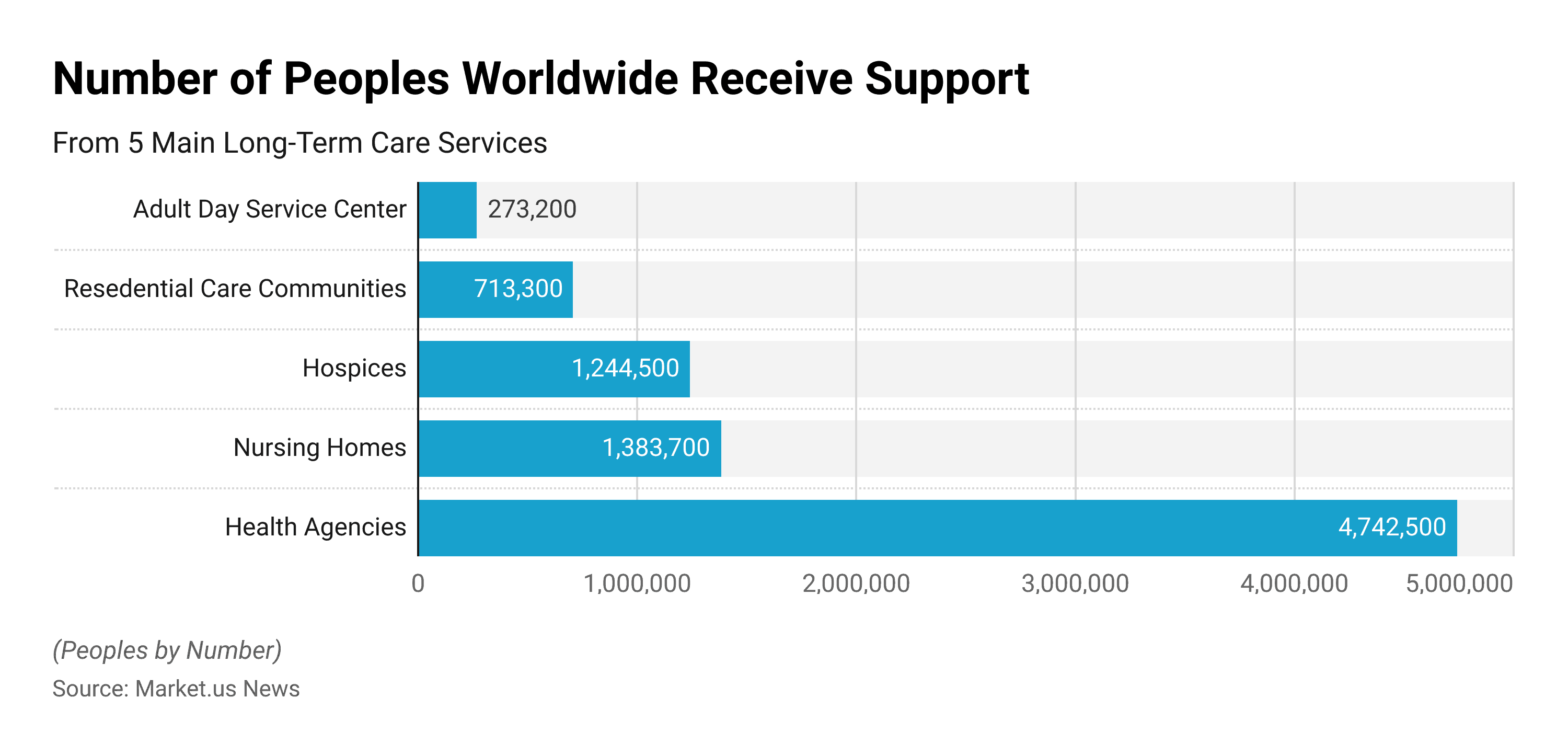
Long-Term Care Resident Demographic Statistics, by Age
Most of the long-term care residents are aged more than 85 years.
- About 7% of residential care communities are aged under 65 years.
- About 38% of residents are aged from 65 to 84 years.
- About 55% of residents are aged more than 85 years.
(Source: aplaceformom)
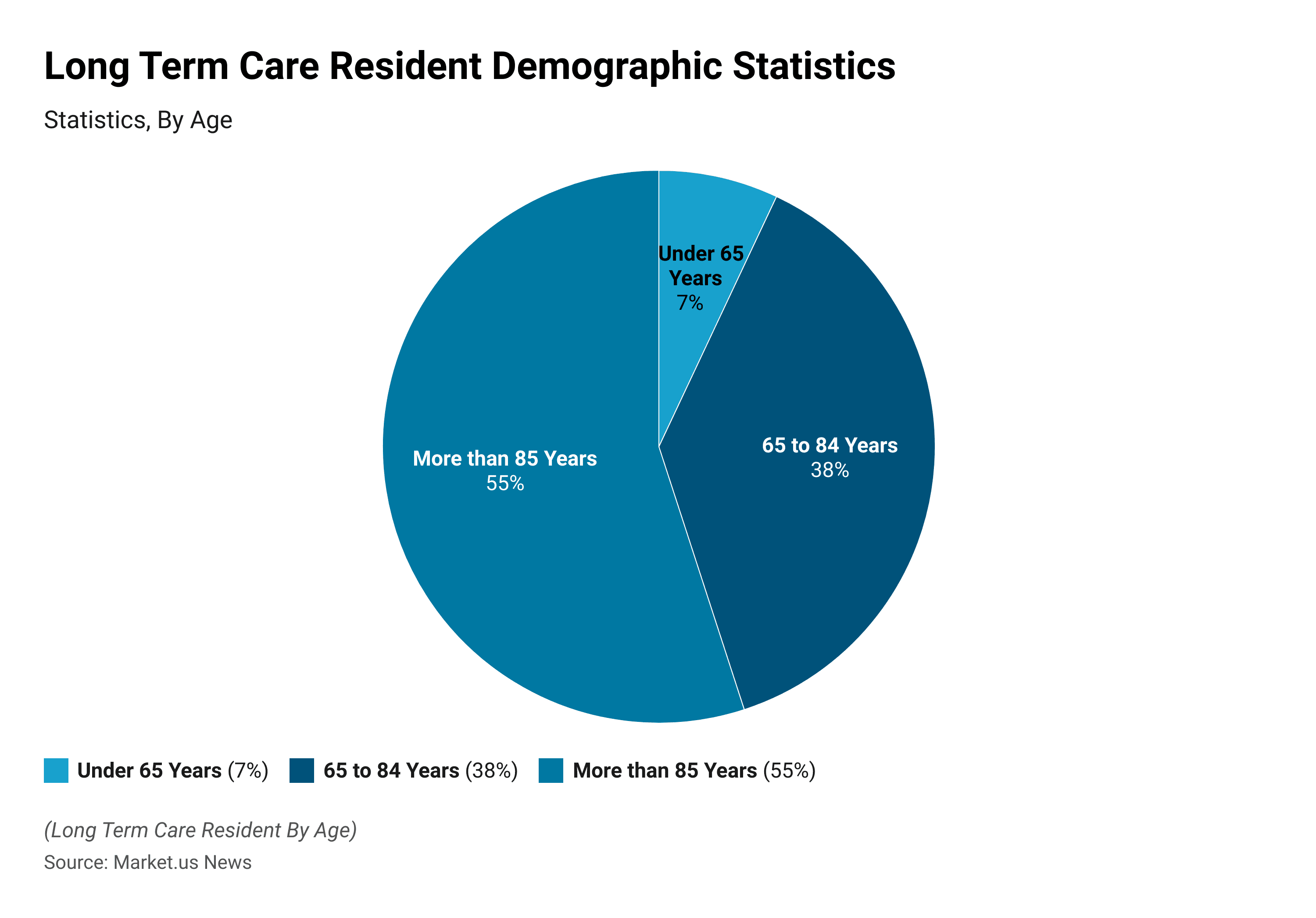
Medical Condition in Long-Term Care Facilities Statistics
Dementia, including Alzheimer’s disease, is a prevalent condition among residents in long-term care facilities. Also, there are major chances of causing cardiovascular diseases, respiratory diseases, and diabetes among the residents in long-term care. This statistic shows the percentage of people who experience common medical conditions living in long-term care facilities.
- 55% of residents have high blood pressure.
- 27% of residents are struggling with the issue of diabetes.
- About 20% of residents are affected by arthritis.
- 17% of residents are struggling with heart disease.
- 12% of residents living in long-term care are affected by osteoporosis.
- 11% of residents have been diagnosed with chronic obstructive pulmonary diseases.
- 10% of residents have stroke issues.
(Source: aplaceformom)
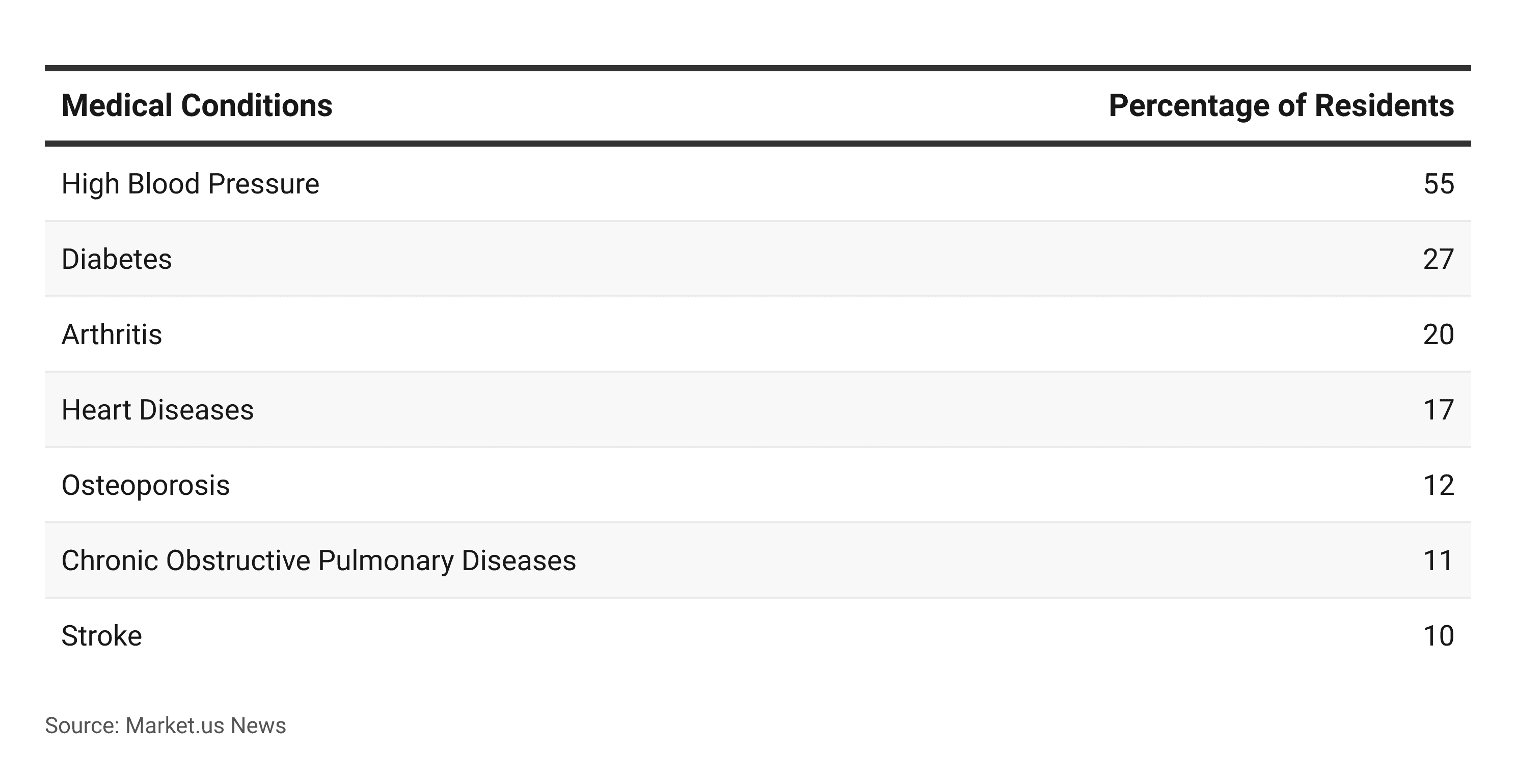
Global Hispanic Market Statistics
Hospice is a unique type of care that focuses on the personal fulfillment of individuals and their guardians dealing with advanced, life-limiting diseases. Hospice care centers aim to treat sickness, wounds, renal disease, or disease and improve a patient’s health. The primary purpose of hospice is to offer patients quality care and make their lives as comfortable as possible.
- According to market.us, the global Hospice Market accounted for revenue of USD 34.5 billion in 2022, and the market is expected to reach a revenue of USD 75.8 billion by 2031.
- The market is growing with a CAGR (2022-2032) of 8.20%.
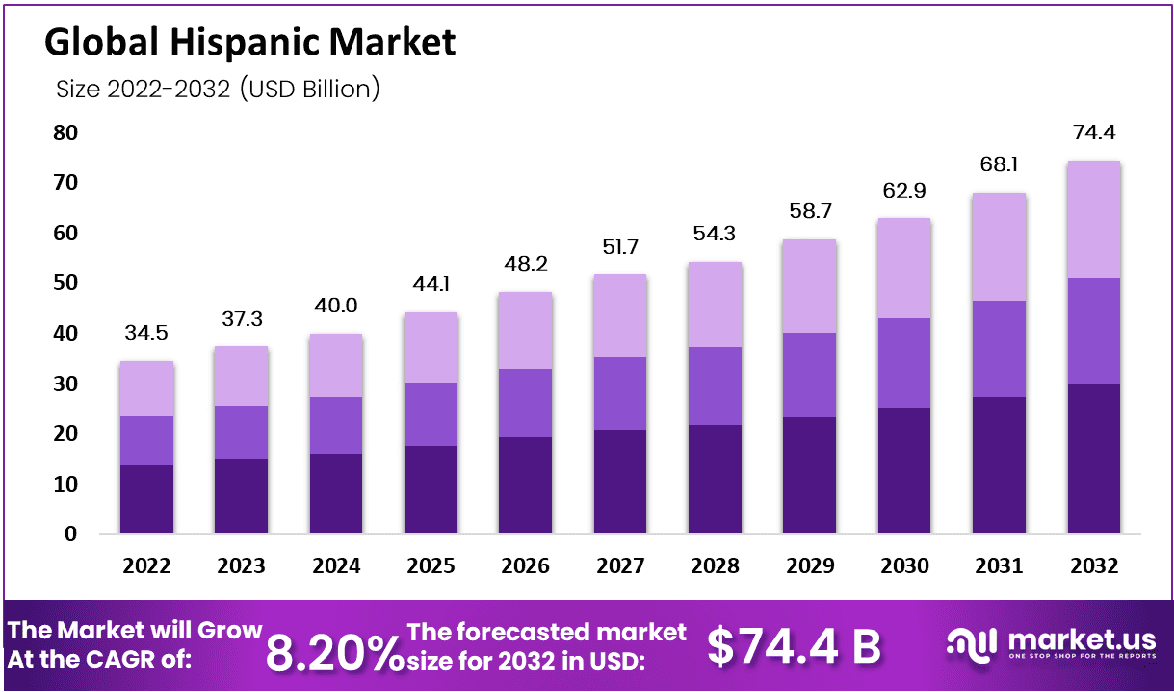
Long-Term Care Statistics – By Country
Long-term care services vary from country to country.
The United States
The aging population in the United States is a major driver of the development of long-term care in the United States. As the baby boomer generation reaches retirement age, the demand for care services is increasing in the United States. Advancements in medical technology and improved healthcare services resulted in increased life expectancy. The passage of the Older Americans Act in 1965 marked a significant milestone in the development of long-term care services in the United States.
- 70% of adults aged 65 years and older will require long-term care in the United States.
- 65.7 million informal and family caregivers provide care to someone who is ill, disabled, or aged in the U.S.
- The total spending for long-term care was USD 219.9 billion in 2012 of all U.S. personal healthcare spending, and this is projected to increase to USD 346 billion in 2040.
- There are about 8.3 million people who receive long-term care services in the United States.
- There are more than 1 million licensed beds for assisted living facilities are there in the United States.
- Most of the assisted living communities are located in the western region of the United States. About 28% are in the South, 23% in the Midwest, and 8% of assisted living communities are in the Northeast.
(Source: caregiver, singlecare)
Nursing homes in the U.S.
- The nursing home is a common type of long-term care service in the United States.
- In 2019 there were about 15,000 nursing homes are there in the United States, and this number is expected to reach 25,000 by the end of the year 2023.
- Nursing facilities employ about 1.6 million people in the United States.
- Texas has the highest number of nursing homes in the US state with 1,214 facilities, among them 1,187 facilities are in California and 952 are in Ohio.
- Alaska has a low number of nursing homes, but the annual cost for a private room in nursing homes is around 436,540 US dollars per year on average.
- Connecticut is the second most expensive state costs around USD 167,900 per year for nursing home services.
- Most residents in the nursing home in the United States are aged between 85 and 94 years.
- About 11.2 % of residents in nursing homes are female, as compared to men (6.1%).
- The common medical conditions among nursing home residents are bladder and bowel incontinence, depression, weight loss, and anxiety.
- About 36.6% of residents in nursing homes have severe cognitive impairment.
(Source: Statista)
The United States Nursing Care Market Size from 2013 to 2024, by Service Statistics
- The nursing care market in the United States accounted for USD 108 billion in 2013. The market generated revenue of USD 182 billion in 2022, and the market is expected to reach a revenue of USD 203 billion in 2024.
(Source: Statista)
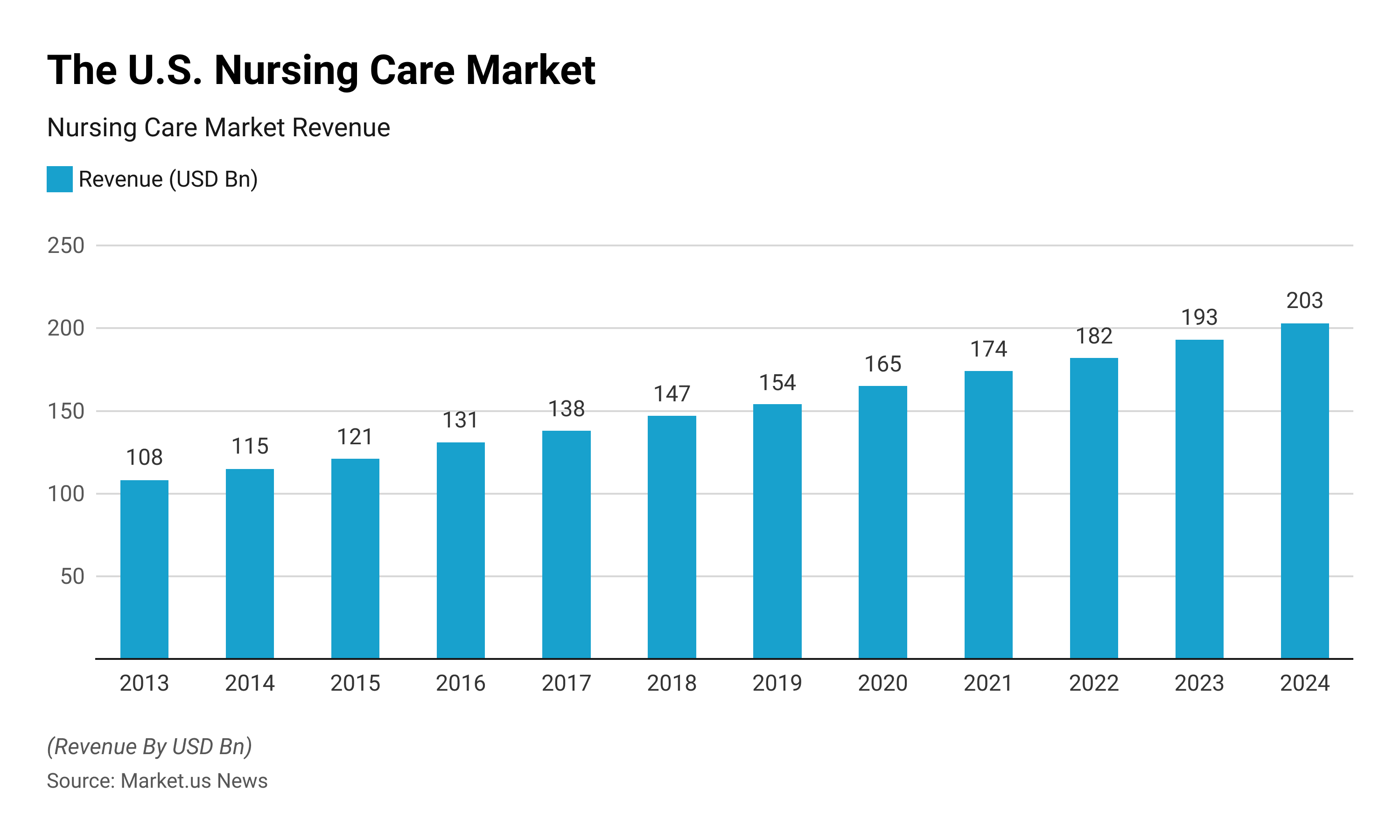
Canada
Long-term care services in Canada include a range of services such as home care, assisted living, and nursing home facilities. Long-term care in Canada is funded through a combination of public funds and individual contributions.
How Many Long-Term Care Beds are there in Canada?
- There are about 2,076 long-term care homes and 198,220 long-term care beds in Canada.
- More than 6,835,866 people aged 65 and older are in Canada.
- In Nova Scotia, there are 33 long-term care beds per 1000 population aged 65 and above.
- In Ontario, there are 30 long-term care beds per 1,000 population aged 65 and older.
- In Manitoba, there are 44 long-term care beds per 1,000 population aged 65 and older.
(Source: CICHI)
Availability of Long Term Care Beds in Canada (Per 1000 Seniors Aged 65+)
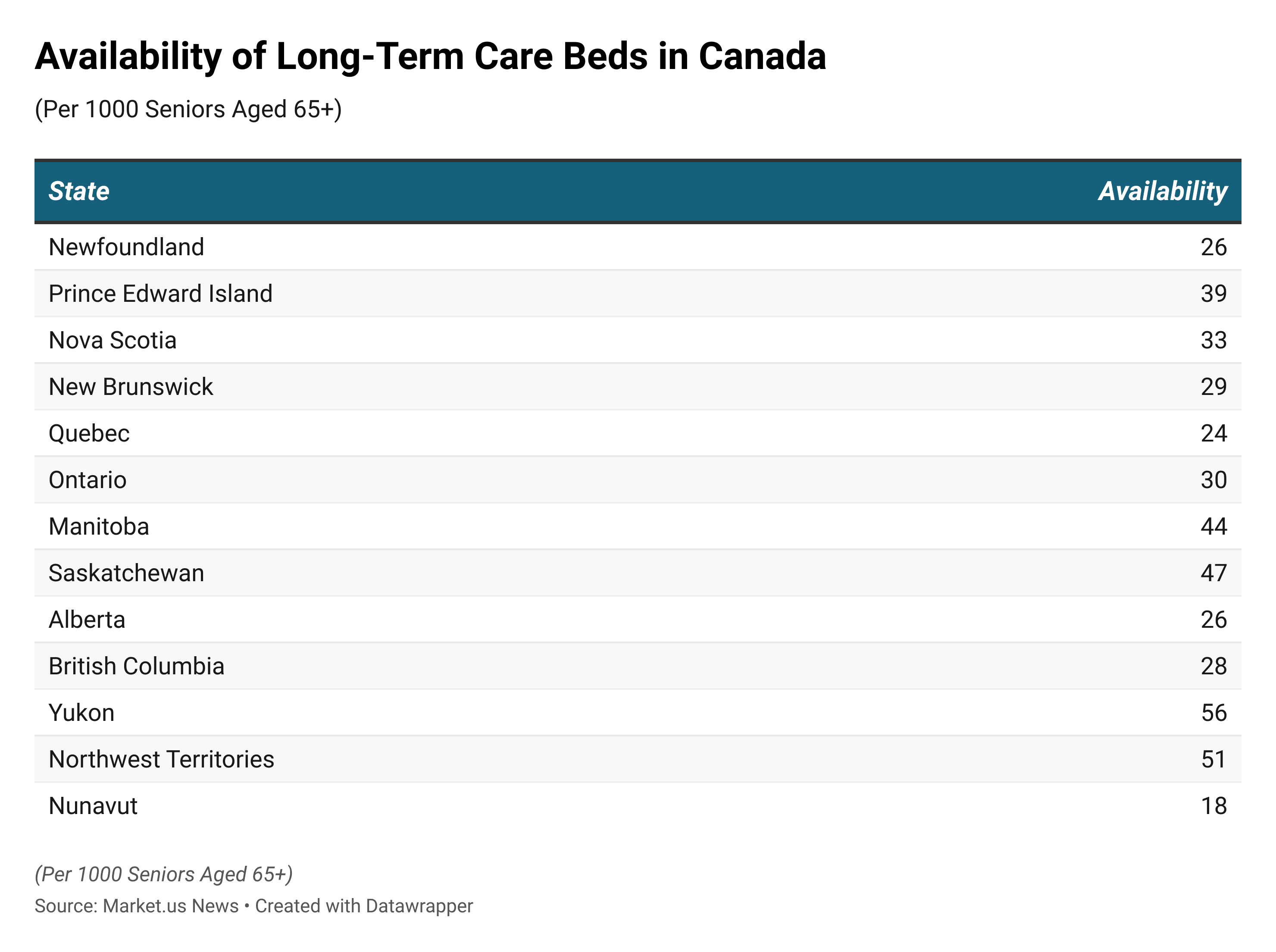
Japan
Long-term care services and their benefits in Japan are distributed under the long-term care insurance (LTCI) system established in 2000. About half of the funding for long-term care is from the public, while the other remaining half is financed by insurance premiums.
- There are two categories of insurance in Japan, the primary insured people are aged from 40 to 64, and the secondary insured people are aged 70 to 90 years.
- More than 31% of the general account expenditure of the Japanese government is allotted to social security expenses.
- 1 in 4 Japanese citizens will be aged more than 75 years by 2025.
- About 6.8 million people in Japan require long-term care services.
- In 2021, there were about 1.8 million certified workers in Japan.
- Due to the low birth rate and high life expectancy, the number of people aged 65 years and above in Japan is increasing and it is expected to reach around 38% of the population in Japan by 2060.
(Source: Statista)
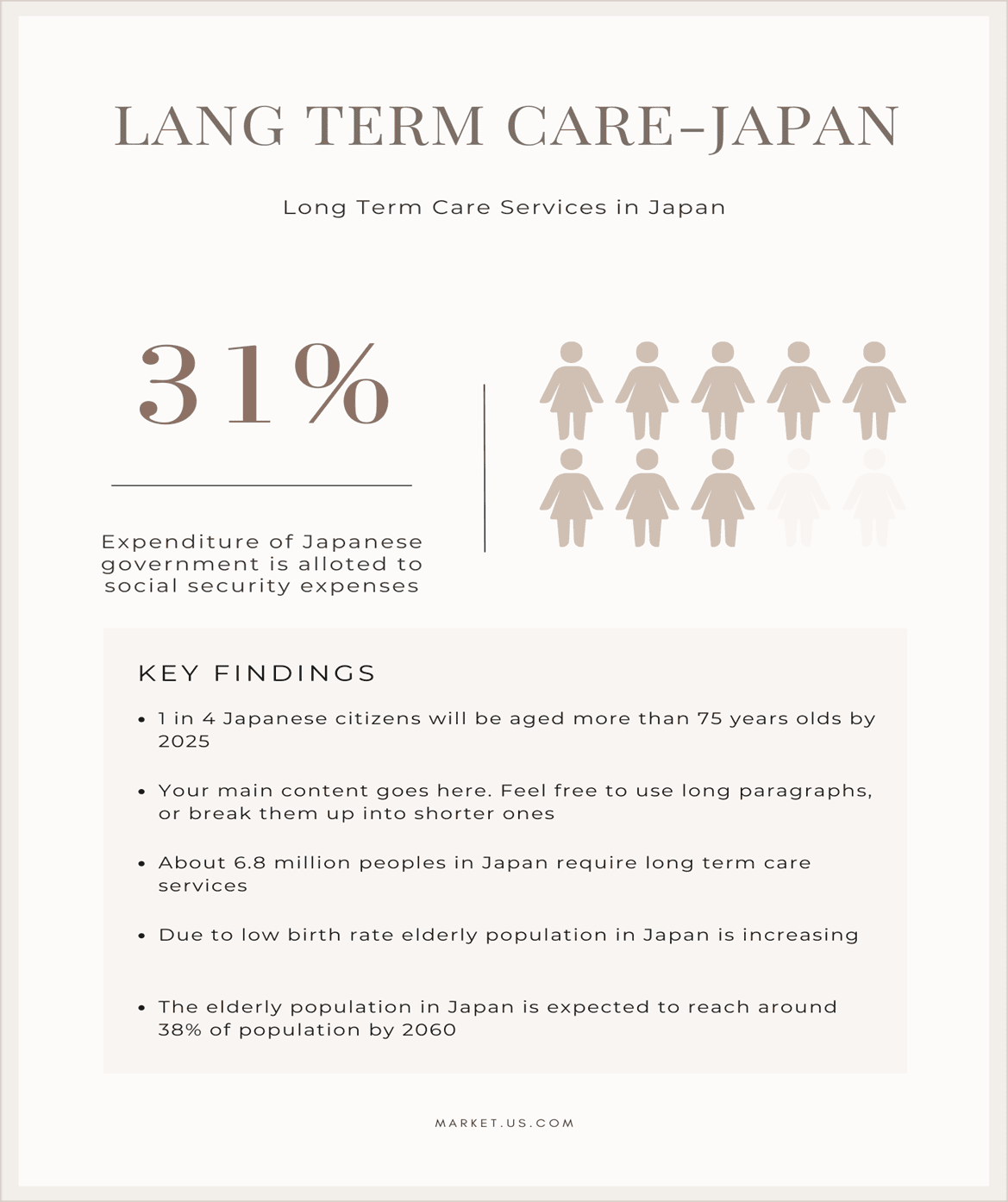
Average Monthly Expenses of Long-Term Care Per Receiver Japan 2022, By Service Statistics
- As of April 2022, the monthly expenses per care recipient for services at nursing facilities in Japan amounted to around 313.7 thousand Japanese yen.
- The monthly expenses per care for community-based service in Japan amounted to around 179.90 thousand Japanese yen.
- Monthly expenses per care recipient for in-home care service and community-based care service amounted to 121.89 and 89.70 thousand Japanese yen respectively.
(Source: Statista)
This statistic shows the average monthly expenses of long-term care per receiver in Japan in 2022, by service (in 1,000 Japanese yen)
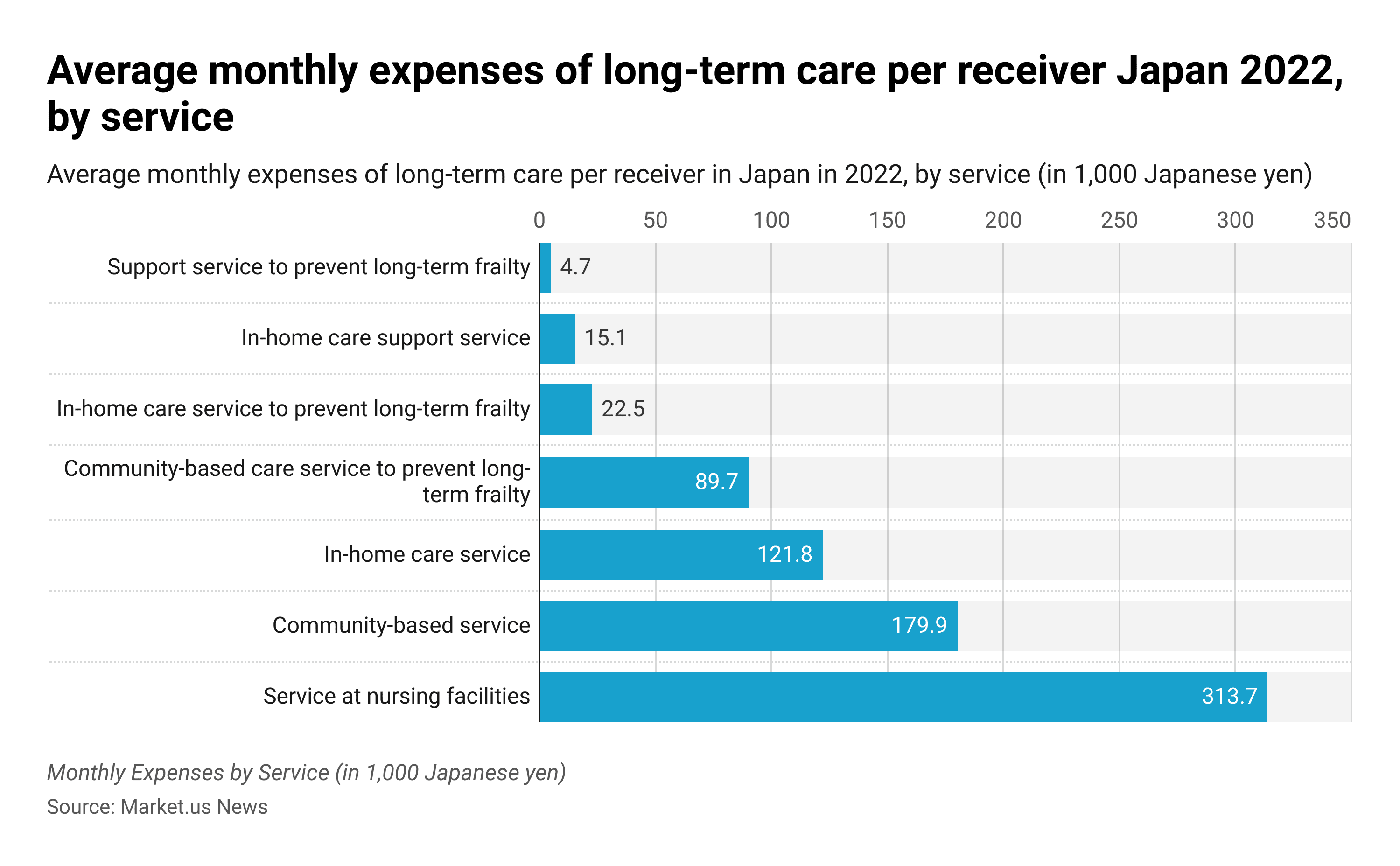
- In 2022, 27% of the budget of the long-term care insurance (LTCI) system in Japan was derived from insurance premiums paid by people aged between 40 to 64 years.
- 23% of the budget of the LTCI system in Japan was derived from insurance premiums paid by people aged 65 years and above.
- About half of the budget for the LTCI system was derived from public expenses paid by the central government, prefectural government, and municipalities.
(Source: Statista)
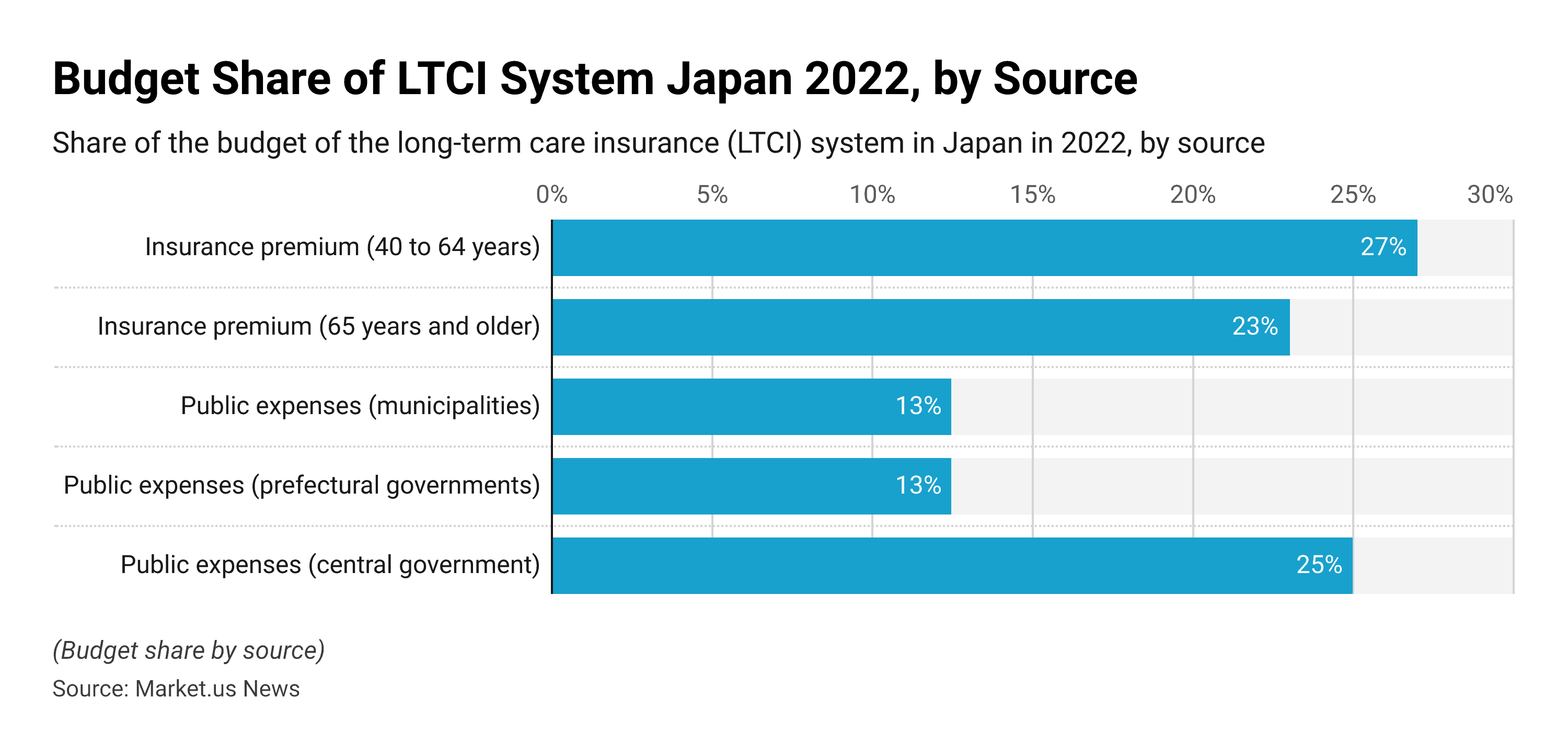
Long-Term-Care Statistics – COVID-19 Impact
COVID-19 impacted in both ways positively and negatively on long-term care market. Personal protective equipment (PPE) and improved cleaning procedures are just two of the infection control methods in which providers have had to make large financial investments.
In response to the pandemic, several regulatory changes have impacted the long-term care industry, including new infection control and prevention requirements. Providers have had to adapt quickly to these changes, which has required additional resources and staff time.
Covid-19 Death Rates Among Long Term Care Residents in Countries Worldwide May 2020
- As of May 25, 2020, there were around 807 deaths due to COVID-19 per million and 400 long-term care deaths per million populations which is comparatively very high as compared to other countries.
- As of May 25, 2020, there were around 295 deaths due to COVID-19 in the United States per million population. Among long-term care residents in the U.S., there were around 91 deaths from COVID-19 per million population.
(Source: Statista)
This statistic shows the total rate of COVID-19 deaths compared to deaths among long-term care residents in select countries worldwide as of May 2020.
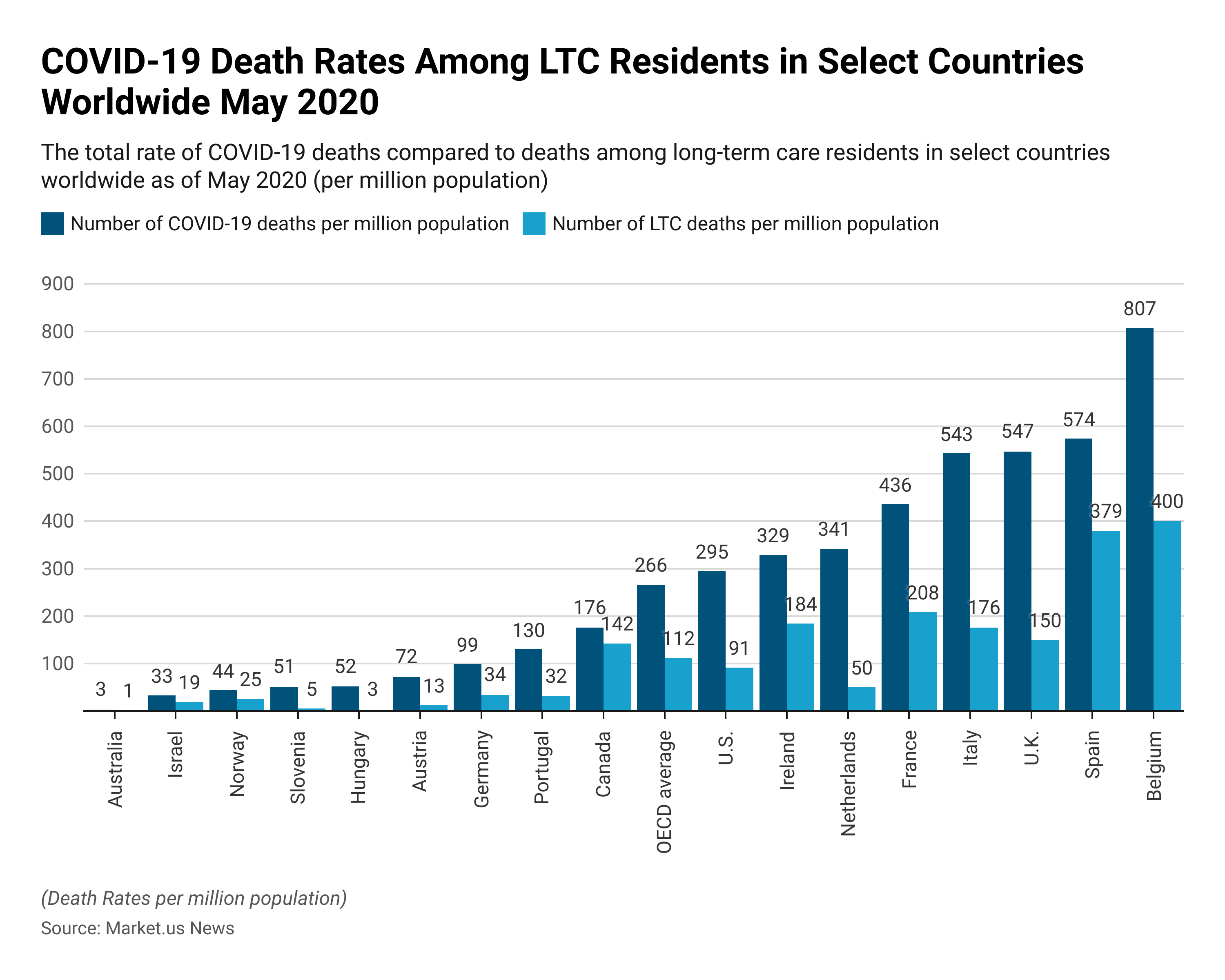
Top Players in the Long-Term Care Market
- Sunrise Carlisle LP
- Atria Senior Living Group
- Extendicare Inc.
- Capital Senior Living
- Diversicare Healthcare Services Inc.
- Kindred Healthcare Inc.
- Genesis Healthcare Corp.
- Senior Care Centers of America
- Home Instead Senior Care Inc.
- Amedisys Inc.
- Brookdale Senior Living Inc.
Recent Developments
Acquisitions and Mergers:
- ElderCare Group acquired Senior Living Solutions for $200 million, consolidating its presence in the long-term care market and expanding its service offerings.
- CareHub merged with LifeCare Services, forming a comprehensive network of long-term care facilities and senior living communities, with combined annual revenues projected to exceed $1 billion.
New Service Launches:
- CareEase introduced a home care subscription service offering personalized assistance with daily activities and medication management, targeting 100,000 subscribers within the first year.
- WellnessLiving launched a virtual wellness program for seniors, providing remote exercise classes and health coaching sessions, aiming to enroll 50,000 participants within six months.
Funding Rounds:
- LongevityCare received $100 million in Series C funding led by Healthcare Investment Group XYZ to expand their network of assisted living facilities and invest in technology for remote patient monitoring, aiming for a 50% increase in occupancy rates within two years.
- SeniorSupport secured $50 million in venture capital funding from Tech Investors ABC to enhance their telemedicine platform and develop digital health solutions for seniors, targeting a 40% growth in user engagement.
Consumer Trends:
- Rising life expectancy and demographic shifts toward an aging population fueled the demand for long-term care services, with occupancy rates in assisted living facilities increasing by 10% compared to the previous year.
- Virtual care solutions witnessed a 20% growth in adoption among seniors, reflecting the growing acceptance of telehealth and remote monitoring technologies in long-term care settings.
Regulatory Landscape:
- Regulatory bodies implemented standards for long-term care facility safety and quality of care, ensuring adherence to regulations and consumer protection in the long-term care market.
Wrap Up
Long-term care plays an important role in supporting individuals who have chronic illnesses, disabilities, or functional limitations and require assistance with daily activities. Long-care systems emerge across countries with different approaches and funding mechanisms in place.
Countries such as the Netherlands, Norway, Sweden, Germany, Japan, Canada, and Denmark are well-developed countries, thus the demand for long-term care is higher in these countries.
Worldwide efforts are ongoing to enhance long-term care systems by implementing several policies, investing in workforce developments, and addressing the needs of individuals requiring long-term care.
It is very important to consider that long-term care is an essential component of the healthcare system and helps individuals to live with dignity, independence, and enhanced quality of life.
FAQs
According to market.us, In 2022, the global long-term care market accounted for USD 1100.7 billion and is expected to reach around USD 2168.1 billion in 2032. Between 2023 and 2032, this market is estimated to register a CAGR of 7.2%.
Long-term care refers to a broad range of services and support provided to individuals who have chronic illnesses disabilities or functional limitations that hinder their ability to perform daily activities independently, these services are designed to assist people with their care needs medical requirements, and overall well-being over an extended period.
Nursing Homes, Assisted Living Facilities, Home Care, Adult Day Care, and Hospice Care are some common types of long-term care.
Discuss your needs with our analyst
Please share your requirements with more details so our analyst can check if they can solve your problem(s)



